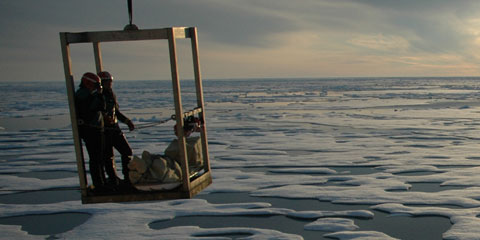NOAA Ship Okeanos Explorer
From February through September 2015, NOAA Ship Okeanos Explorer will investigate ocean areas in the Caribbean and Pacific Ocean. Scientists, technicians, and engineers at sea and ashore will map and explore geological, biological, archaeological, and chemical features and telepresence technology will allow scientists and members of the public ashore to follow discoveries via live streaming video from the seafloor.
In the Caribbean, Okeanos Explorer will focus on deepwater habitats on Caribbean seamounts and in trenches, including the Puerto Rico Trench where the remotely operated vehicle Deep Discoverer will be tested to its rated depth of 6,000 meters. These expeditions will complement previous work by Exploration Vessel Nautilus.
In July, Okeanos Explorer will join with other NOAA and external partners to initiate the Campaign to Address Pacific Monument Science, Technology, and Ocean NEeds, or CAPSTONE, to collect baseline information supporting science and management requirements associated with U.S. marine national monuments and other protected places in the Pacific Ocean. These expeditions will also highlight the uniqueness and importance of these symbols of ocean conservation. Okeanos Explorer will work in and around Papahānaumokuākea Marine National Monument and the Hawaiian Islands Humpback Whale National Marine Sanctuary and will complement Schmidt Ocean Institute’s previous field work.
Arctic Projects
OER is partnering with the U.S. Integrated Ocean Observing System (IOOS), NASA, and the Bureau of Ocean Energy Management (BOEM) to initiate the first U.S. network to monitor marine biodiversity at scales ranging from microbes to whales. Such a network is anticipated to serve as a management tool to conserve existing biodiversity and address threats such as invasive species and infectious agents. Three demonstration networks, one of which will occur in the Arctic’s Chukchi Sea, will be prototypes for potential development of a national marine biodiversity observation network.

Scientists are lowered down onto Arctic ice in a “man lift.” Sea-ice supports a variety of life and is integral to the Arctic Ocean’s food web. Image courtesy of The Hidden Ocean, Arctic 2005 Exploration, NOAA-OE.
A multi-year Marine Ecosystem Study, or MARES, is designed to monitor and understand ecosystem dynamics of the Beaufort Sea. The study responds to national and international attention to climate change, energy development, and related issues in the region, and OER is considering ways to engage with BOEM and others in this study.
The fiscal year 2015 OER Federal Funding Opportunity is Arctic-focused.
Genomics
OER is teaming with NOAA Fisheries, the Atlantic Oceanographic and Meteorological Laboratory, and IOOS, as well as the J. Craig Venter Institute and Scripps Institution of Oceanography, to enhance ecosystem observation programs by integrating genome-enabled techniques and technologies into the California Cooperative Oceanic Fisheries Investigations (CalCOFI), a multi-partner long-term ecosystem and fisheries study off the coast of California. Integration is expected to help scientists better understand the diversity and functional activity of microbes, enabling more accurate prediction of ecosystem tipping points, ecosystem resiliency, and prediction of ocean response to large-scale pressures, including climate change. The project is a pilot for applications in other regions.
Next page

